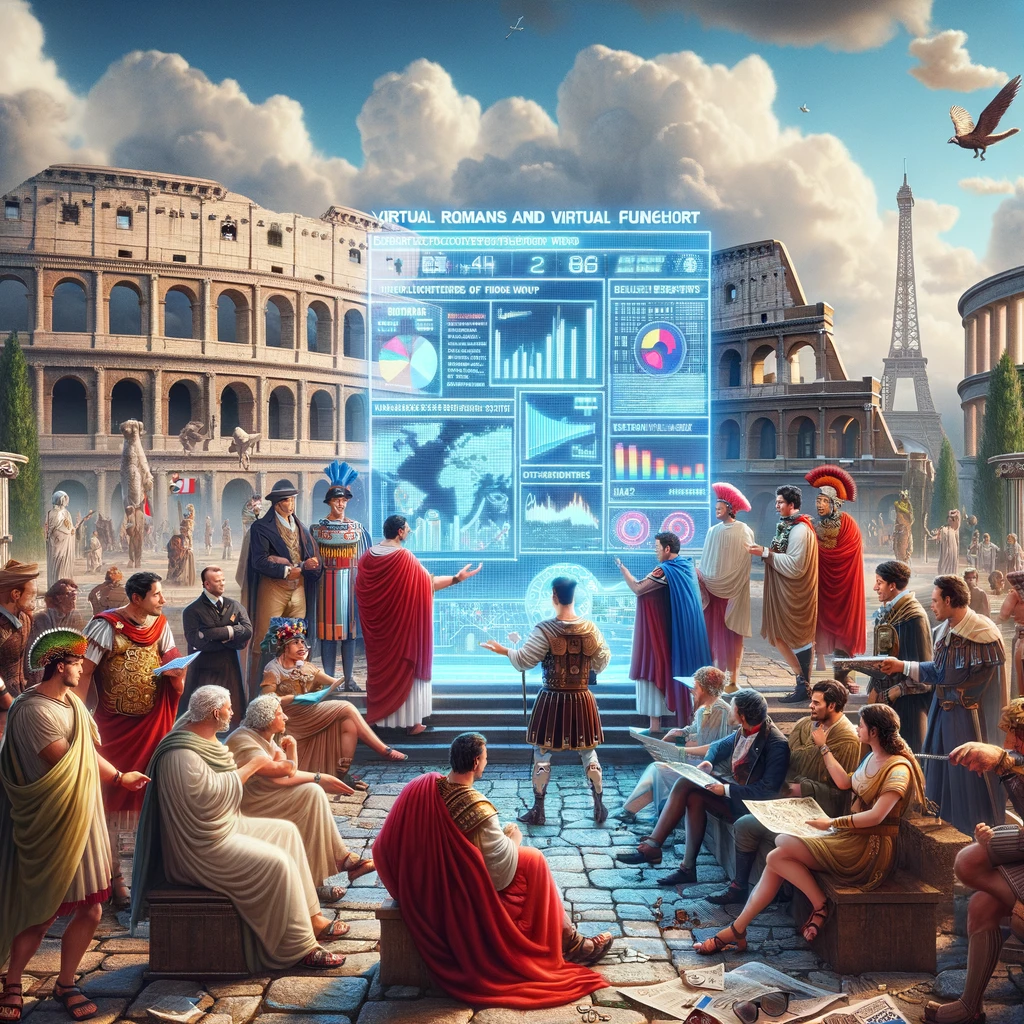Abstract
The oversaturation of information flows and the competition among diverse viewpoints underscore the significance of every message that captures the audience’s attention and provokes discussion. Thus, exploring new formats and methods for attracting attention to news agendas, analyzing innovative persuasion techniques, and scrutinizing gaps and overlooked aspects in discussion platforms become particularly crucial in cutting-edge media studies. One such innovative format for news perception and discussion can be found in virtual pseudo-historical public pages on VK. These pages engage with the real socio-political news agenda, stylized as events from different eras such as ancient Rome and 19th-century France.
The aim of our research is to identify techniques for attracting attention, encouraging discussion, and persuading audiences in these selected public forums. We analyzed the characteristics of recontextualized news presentations, including the transposition of time and place, renaming key figures and technologies, and the nuances of internal humor on these public pages. A primary focus of these pages is political news, particularly the Russian-Ukrainian crisis, which is metaphorically represented through the lens of the Punic or Napoleonic wars. This juxtaposition of historical and contemporary perspectives enables users to interpret the political agenda differently. This pseudo-historical linguistic play and unique humor bypass critical perception filters, and once readers accept the internal logic of the public pages, they also tend to accept the narratives presented. The ability to comment on posts allows users to engage in the same narrative style, broaden the scope of news discussions, and involve their friends by reposting to their own pages.
References
Altheide, D. L., & Snow, R. P. (1979). Media Logic. Sage.
Banis, D. (2018). Fictiocracy: Media and Politics in the Age of Storytelling. The Institute of Network Cultures (INC). https://networkcultures.org/longform/2018/02/22/fictiocracy-media-and-politics-in-the-age-of-storytelling/
Bogost, I., Ferrari, S., & Schweizer, B. (2010). Newsgames: Journalism at Play. The MIT Press. https://doi.org/10.7551/mitpress/8854.001.0001
Boylorn, R. M. (2021). Visual voices and aural (auto)ethnographies: The personal, political, and polysemic value of storytelling and/in communication. Review of Communication, 21(1), 1–8. https://doi.org/10.1080/15358593.2021.1905870
Bulgakova, A. A. (2021). Creating a New World: Transmedia Storitelling Principles in the COVID-19 Pandemic News Discourse. Actual issues of modern philology and journalism, 3(42), 82–90. https://doi.org/10.14529/ssh210411 (In Russian).
Chernenko, Yu. A. (2018). The “House of Cards” of Political Reality. The Art and Science of Television, 14(1), 184–210. https://doi.org/10.30628/1994-9529-2018-14.1-184-210 (In Russian).
Chernykh, A. I. (2012). Media Rituals. Sociological Journal, 4, 106–129. (In Russian).
Chetina, E. M., & Klyuykova, E. A. (2015). Fandoms and Fanfics: Creative Practices on Virtual Platforms. Perm University Herald. Russian and Foreign Philology, 3, 95–104. (In Russian).
Dmitriev, A. V., & Sychev, A. A. (2005). Smekh: Sotsiofilosofskiy analiz. Al'fa. (In Russian).
Dunas, D. V. (2021). Mediapotreblenie “tsifrovoy molodezhi” v Rossii. Izdatel'stvo Moskovskogo universiteta. (In Russian).
Hedling, E. (2020). Storytelling in EU public diplomacy: Reputation management and recognition of success. Place Branding and Public Diplomacy, 16, 143–152. https://doi.org/10.1057/s41254-019-00138-2
Hepp, A., & Krotz, F. (2014). Mediatized Worlds: Culture and Society in a Media Age. Palgrave. https://doi.org/10.1057/9781137300355_1
Huizinga, J. (2011). Homo Ludens. Izdatel'stvo Ivana Limbakha. (In Russian).
Ivanova, E. M. (2017). Classic Domestic Thinkers’ Ideas on Humor and Laughter and Modern Psychology of Humor. Studia Culturae, 1(31), 57‒74. (In Russian).
Korobko, M. A. (2015). Sootnoshenie kanona i fanona (na materiale fandomov «Sherlok», «Merlin», «Sverkh"estestvennoe»). Vestnik Bryanskogo gosuniversiteta, 2, 254–256. (In Russian).
Lilleker, D., & Veneti, A. (2023). Research Handbook on Visual Politics. Edward Elgar Publishing. https://doi.org/10.4337/9781800376939
Luhmann, N. (2012). Real'nost' massmedia. Kanon+; ROOI Reabilitatsiya. (In Russian).
Martin, R. (2009). Psikhologiya yumora. Piter. (In Russian).
McQuail, D. (2014). Zhurnalistika i obshchestvo: Uchebnik dlya zhurnalistov. MediaMir. (In Russian).
Micalizzi, A., & Piccioni, T. (2022). “In front of you”: Public figures and personal images in the digital arena. The visual storytelling of politics and its effects. Mediascapes Journal, 20, 109–130.
Monahan, B., & Maratea, R. J. (2021). The Art of the Spiel: Analyzing Donald Trump’s Tweets as Gonzo Storytelling. Symbolic Interaction, 44(4), 699–727. https://doi.org/10.1002/symb.540
Nišić, V., & Plavšić, D. (2014). The role of media in the construction of social reality. Sociological Discourse, 4(7), 73–81. https://doi.org/10.7251/SOCEN1407073N
Osmanova, D. N. (2019). Multimedia Storitelling as a Form of Revival of Mytho-Folklor Communication Under the Conditions of Modern Media Space (within the Framework of Theory G.M. Mcluen). Foreign Languages in Uzbekistan, 6, 173–186. https://doi.org/10.36078/1581927480 (In Russian).
Pyanykh, E. P. (2019). Carnival discourse network subculture. Bulletin of Chelyabinsk State University, 8, 44–50. https://doi.org/10.24411/1994-2796-2019-10807 (In Russian).
Raynauld, V., & Lalancette, M. (2021). Pictures, Filters, and Politics: Instagram’s Role in Political Image Making and Storytelling in Canada. Visual Communication Quarterly, 28(4), 212–226. https://doi.org/10.1080/15551393.2021.1986827
Shakhova, I. A. (2022). Tricksters as a Factor in Society’s Social Transformation. Society: Sociology, Psychology, Pedagogics, 8, 62–66. https://doi.org/10.24158/spp.2022.8.8 (In Russian).
Suls, J. (1983). Cognitive processes in humor appreciation. In Handbook of humor research: Basic issues (Vol. 1, pp. 1–57). https://doi.org/10.1007/978-1-4612-5572-7_3
Tertychny, A. A. (2018). Objective information in media: is it reachable? Belgorod State University Scientific bulletin, 1, 98–104. https://doi.org/10.18413/2075-4574-2018-37-1-113-120 (In Russian).
Tiupa, V. I. (2017). New Discourse as Narratological Problem. The New Philological Bulletin, 3, 40–51. https://doi.org/10.24411/2072-9316-2017-00010 (In Russian).
Volkova, I. I. (2014). Multimedia Journalism: Newsgames. RUDN Journal of Studies in Literature and Journalism, 1, 105–112. (In Russian).
What is Storitelling? (2018). National Storitelling Network. https://storynet.org/what-is-storytelling/
Wyer, R., & Collins, J. (1992). A Theory of Humor Elicitation. Psychological Review October, 99(4), 663–688. https://doi.org/10.1037/0033-295X.99.4.663

This work is licensed under a Creative Commons Attribution 4.0 International License.


